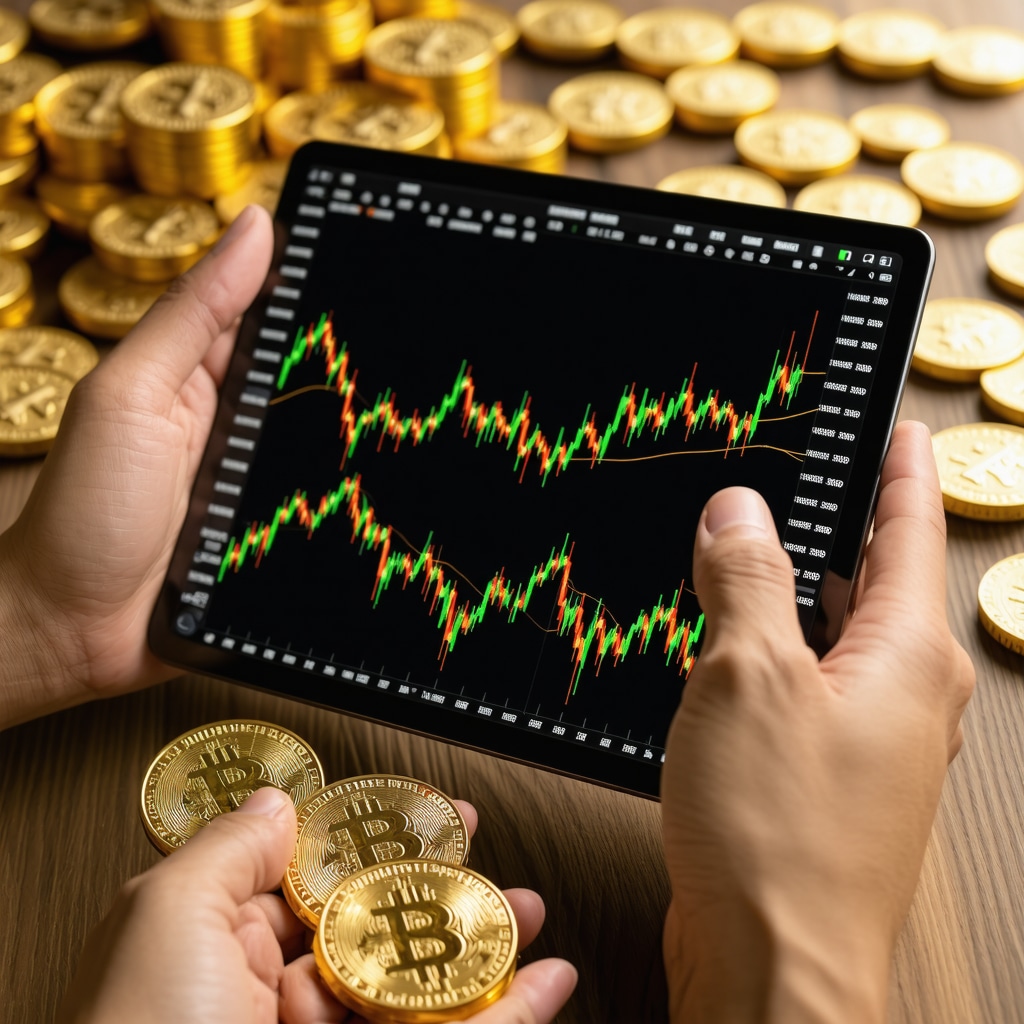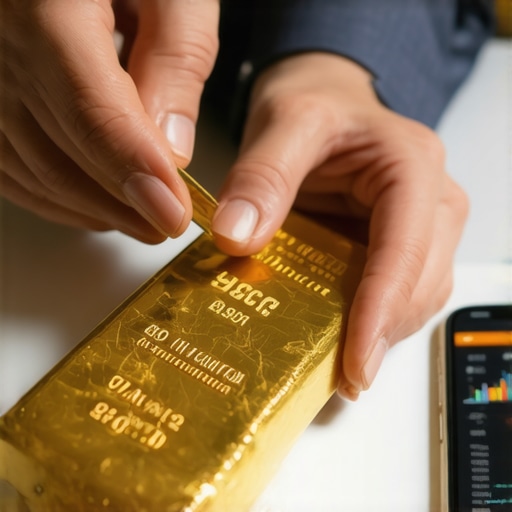Unlocking the Golden Path: Why Start Investing in Gold?
Gold has long been revered as a safe haven asset, a resilient store of value that weathers economic storms and market volatility. For beginners, diving into gold investment can seem daunting, but understanding its unique characteristics can transform hesitation into opportunity. Gold not only diversifies portfolios but also acts as a hedge against inflation and currency fluctuations, making it a vital component for long-term financial security.
Decoding the Types of Gold Investments: From Physical Bullion to Digital Assets
The world of gold investing offers a spectrum of options tailored to different risk appetites and investment goals. Physical gold—such as coins, bars, and bullion—provides tangible ownership and can be a comforting asset during uncertain times. Alternatively, gold ETFs and mutual funds offer liquidity and ease of trading without the complexities of storage. For those seeking growth potential, gold mining stocks present an opportunity but come with additional market risks tied to the companies’ operational performance.
Choosing the right form depends on your investment horizon, risk tolerance, and personal preferences. Beginners often benefit from starting with physical gold or gold ETFs to gain exposure without overwhelming complexity. More insights on choosing the right gold investment vehicle can be found in our comprehensive guide to top gold investment types.
Strategic Steps to Begin Your Gold Investment Journey
Starting with gold investment requires a clear plan. First, define your investment objectives—whether wealth preservation, inflation hedging, or speculative gains. Next, set a realistic budget, keeping in mind that gold prices fluctuate and liquidity varies by investment type. Research trusted dealers or platforms if buying physical gold, ensuring authenticity and secure storage options.
Begin with smaller purchases to familiarize yourself with market dynamics and gradually build your position. Monitoring gold price trends and understanding market demand drivers, such as geopolitical tensions or central bank policies, can enhance timing your investments effectively. For a deep dive into market influences, explore how gold demand trends impact prices.
How Can Beginners Safely Verify and Purchase Physical Gold?
Verifying the authenticity of physical gold is crucial to avoid counterfeit risks. Beginners should seek certified gold with recognized hallmarks and purchase from reputable dealers with transparent credentials. Using third-party appraisals or leveraging online verification tools can provide additional assurance. Storing physical gold securely—whether in a safe deposit box or insured home safe—is equally important to protect your investment.
Enhance Your Gold Investment Knowledge and Confidence
Investing in gold is not just about buying an asset; it’s about understanding the market’s intricate mechanisms and aligning them with your financial goals. Engage with expert analyses, follow gold price forecasts, and participate in communities focused on precious metals investment. Our article on choosing your first bullion offers practical tips for newcomers.
Remember, gold investment demands patience and continuous learning. By starting thoughtfully, you position yourself to leverage gold’s enduring value effectively.
Feel inspired to start your gold investment journey? Share your thoughts or questions below to join the conversation and learn from fellow investors!
For further authoritative insights on gold’s role in portfolio diversification and as a hedge against economic uncertainty, refer to the World Gold Council’s detailed research available at Goldhub Research.
Personal Lessons on Managing Risks and Expectations in Gold Investing
Reflecting on my own journey investing in gold, one thing that became crystal clear was how vital it is to manage both risks and expectations. Gold, while often viewed as a stable asset, can experience significant price swings based on a myriad of factors like geopolitical events, currency fluctuations, and central bank policies. Early on, I learned that patience and a calm approach are essential. Jumping into gold investments with the hope of quick profits can lead to disappointment, especially if you don’t stay informed or diversify your holdings.
One practical step I took was to split my investments between physical gold and gold ETFs. This approach gave me the tangible security of physical bullion and the liquidity and ease of trading ETFs. This balance helped me navigate market dips without panic and take advantage of opportunities when prices were favorable.
Understanding Gold’s Role Beyond Just an Investment
Gold is more than just a financial asset; it holds emotional and cultural significance for many people worldwide. For me, owning physical gold feels like holding a piece of history and security that transcends numbers and charts. This emotional connection can also influence how one approaches gold investment. Recognizing this helped me avoid treating gold purely as a speculative commodity and instead focus on its long-term value and stability.
Have You Considered How Your Personal Goals Influence Your Gold Investment Strategy?
This question often came up during conversations with fellow investors and made me reflect deeply on my own motivations. Are you investing in gold primarily for wealth preservation, inflation protection, portfolio diversification, or potential growth? Your answer can significantly shape the types of gold investments you pursue and how you respond to market movements. For example, if your goal is inflation hedging, physical gold or gold-backed IRAs might be more suitable, whereas for growth, gold mining stocks or mutual funds could be more appropriate.
Integrating Trusted Research into Your Investment Decisions
Throughout my investing experience, I found that supplementing personal insights with expert research was invaluable. The World Gold Council offers comprehensive data and analysis that helped me understand market trends and demand dynamics better. For instance, their reports on gold demand trends and price drivers provided clarity on how global events and central bank actions impact gold prices. This knowledge empowered me to make informed decisions rather than react impulsively to short-term market noise.
Practical Advice for Securing and Growing Your Gold Investment
One tip I can’t emphasize enough is the importance of secure storage when dealing with physical gold. Whether you choose a bank safe deposit box or a reputable private vault, ensuring your gold’s safety protects your investment from theft or damage. Additionally, regular portfolio reviews to adjust your gold allocation in response to changing market conditions or personal financial goals have helped me maintain a balanced and resilient investment strategy.
If you’re interested in learning about the nuances between gold coins and bars or how to safely buy gold online, our physical gold investment tips guide offers practical steps tailored for beginners.
What has been your experience with gold investing? Have you found certain strategies or forms of gold particularly suited to your goals? Feel free to share your journey or ask questions in the comments—let’s learn together!

Mastering Market Timing: Leveraging Economic Indicators for Gold Investment Success
One of the more sophisticated aspects of gold investing is understanding how to interpret macroeconomic signals to optimize entry and exit points. Unlike stocks or bonds, gold’s price is intricately tied to factors such as real interest rates, inflation expectations, currency strength, and geopolitical tensions. For instance, when real interest rates (adjusted for inflation) drop below zero, gold often becomes more attractive since it doesn’t yield interest but preserves purchasing power. Monitoring indicators like the U.S. Treasury Inflation-Protected Securities (TIPS) breakeven rate or Federal Reserve policy signals can provide early warnings on potential gold price movements.
Seasoned investors also watch the U.S. dollar index closely, given gold’s inverse relationship with the dollar. A weakening dollar generally propels gold prices upward, as gold becomes cheaper in other currencies, increasing demand. Incorporating these economic indicators into your strategy can elevate your gold investments from a passive hedge to a dynamic portfolio component.
How Do Central Bank Gold Reserves Influence Global Gold Prices?
Central banks are pivotal players in the gold market, often acting as both buyers and sellers of the metal. Their reserve policies can significantly impact global supply and demand dynamics. When central banks increase their gold reserves, it signals confidence in gold’s long-term value and can drive prices higher. Conversely, large-scale sales can temporarily suppress prices. Understanding central bank behavior requires analyzing official reports and international agreements, such as the Central Bank Gold Agreement (CBGA), which governs coordinated sales to prevent market disruption.
Research from the World Gold Council provides detailed insights into how central bank activities have historically influenced gold price trends, highlighting their strategic role in portfolio diversification and monetary policy implementation.
Integrating Gold with Diversified Portfolios: Advanced Asset Allocation Techniques
For investors aiming to harness gold’s full potential, integrating it thoughtfully within a diversified portfolio is crucial. Modern portfolio theory advocates holding assets with low or negative correlations to reduce overall volatility and enhance risk-adjusted returns. Gold often exhibits negative correlation to equities and bonds during market downturns, making it a powerful diversification tool.
Advanced investors employ allocation models that dynamically adjust gold holdings based on market conditions and personal risk tolerance. For example, a tactical asset allocation approach might increase gold exposure during periods of anticipated inflation or geopolitical instability while reducing it when economic growth prospects improve. Utilizing tools such as mean-variance optimization and stress testing can help tailor gold allocations that align with complex financial goals and risk management frameworks.
Mitigating Risk: Navigating Counterparty and Liquidity Challenges in Gold ETFs and Mining Stocks
While physical gold offers tangible security, many investors prefer the liquidity and convenience of gold ETFs and mining stocks. However, these instruments introduce counterparty and operational risks that require careful consideration. Gold ETFs, for instance, depend on custodians to hold physical gold securely; any lapse can jeopardize investor assets. Additionally, ETFs may face liquidity constraints during extreme market stress, potentially leading to price deviations from the underlying gold value.
Gold mining stocks compound these risks with exposure to company-specific factors such as management efficacy, production costs, and geopolitical risks in mining jurisdictions. An in-depth fundamental analysis and diversification across multiple mining companies can mitigate such risks. Monitoring metrics like reserve life, production costs per ounce, and geopolitical risk indices is essential for sophisticated investors seeking to balance growth potential with risk.
What Are the Best Practices for Safeguarding Physical Gold Investments Against Fraud and Theft?
Ensuring the security of physical gold involves a multi-layered approach. Beyond purchasing from reputable dealers with proper certification, investors should employ secure storage solutions such as insured private vaults or allocated storage accounts with trusted custodians. Utilizing tamper-evident packaging and periodic audits can further protect against fraud. Insurance coverage tailored specifically for precious metals adds another critical layer of security.
Consulting specialized firms that offer vaulting and authentication services, such as Brink’s or The London Vaults Group, can provide peace of mind for investors holding significant physical gold positions.
Ready to deepen your gold investment expertise? Explore our advanced resources and connect with industry experts to refine your strategy and safeguard your assets.
Decoding Central Bank Dynamics: Strategic Insights for Gold Price Forecasting
Central banks play an instrumental role in shaping gold market trajectories through their reserve management policies. Beyond mere accumulation or liquidation, these institutions engage in nuanced strategies that reflect broader monetary policy objectives and geopolitical considerations. For instance, coordinated sales agreements like the Central Bank Gold Agreement (CBGA) have historically mitigated market shocks by regulating gold supply. Understanding these subtleties enables investors to anticipate pivotal shifts in gold prices, especially when central banks signal changes in reserve allocations or intervene during currency crises.
How Can Investors Leverage Central Bank Gold Reserve Trends to Anticipate Market Movements?
Tracking central bank gold reserve activity requires analyzing detailed monthly and quarterly reports, often published by the World Gold Council and national financial authorities. These datasets reveal patterns of accumulation or divestment that precede shifts in gold’s valuation. For instance, a sustained increase in reserves by emerging market central banks often correlates with a bullish outlook on gold, reflecting diversification away from fiat currencies. Conversely, unexpected sales might indicate liquidity needs or shifts in monetary policy priorities. Sophisticated investors integrate these signals with macroeconomic data to refine timing and positioning.
For comprehensive data and analytical tools on central bank gold reserves, consult the World Gold Council’s authoritative research platform, which offers granular insights into portfolio diversification strategies employed by sovereign wealth funds and central banks globally.
Enhancing Portfolio Resilience: Dynamic Allocation Models Incorporating Gold
Integrating gold into diversified portfolios transcends static allocation; it calls for adaptive models responsive to evolving market cycles and investor risk profiles. Techniques such as mean-variance optimization can be augmented with scenario analyses incorporating inflation shocks, currency fluctuations, and geopolitical stressors. Allocations may dynamically shift from traditional equities to gold during anticipated downturns, enhancing risk-adjusted returns while preserving capital.
Moreover, incorporating gold derivatives or structured products may offer tactical exposure with tailored risk-return profiles. However, these instruments necessitate a deep understanding of derivative mechanics and counterparty risks. Employing backtesting and stress-testing frameworks ensures that gold’s inclusion aligns with overarching financial goals and mitigates unintended volatility.
Advanced Risk Mitigation: Navigating Counterparty and Operational Risks in Gold-Related Securities
While gold ETFs and mining stocks provide liquidity and growth potential, they introduce complex risks not inherent in physical gold ownership. Counterparty risk in ETFs arises from reliance on custodians and market makers; operational risks include potential mismanagement or liquidity crunches during systemic shocks. Mining stocks compound these risks with geopolitical exposures, regulatory changes, and operational inefficiencies.
Expert investors conduct rigorous due diligence, analyzing financial statements, production cost structures, and geopolitical risk indices. Diversification across multiple mining companies and geographies, coupled with hedging strategies, can attenuate idiosyncratic risks. Regular monitoring and engagement with company disclosures further safeguard investment integrity.
What Best Practices Ensure Robust Security and Authenticity for High-Value Physical Gold Holdings?
Securing substantial physical gold assets demands a comprehensive approach combining authentication, secure storage, and insurance. Authentication should involve certified assay laboratories and provenance documentation. For storage, allocated vaults managed by reputable firms like Brink’s or The London Vaults Group offer insured, tamper-evident solutions with audit trails. Insurance policies tailored to precious metals cover theft, loss, and damage, providing an additional safeguard against unforeseen events.
Periodic audits and employing tamper-evident packaging further enhance security. Engaging with specialized precious metals security consultants can yield bespoke risk management frameworks, aligning storage solutions with the investor’s portfolio scale and risk appetite.
Elevate Your Gold Investment Strategy Through Expert Knowledge and Adaptive Practices
Mastering gold investment at an advanced level requires continuous assimilation of market intelligence, macroeconomic insights, and emerging financial instruments. By integrating central bank reserve trends, dynamic portfolio allocation, and rigorous risk management, investors can transform gold from a passive hedge into an active wealth enhancement tool. Engage with specialized forums, subscribe to industry-leading analytics, and consult with precious metals experts to refine your strategy.
Ready to elevate your gold investment acumen? Dive deeper with our exclusive advanced resources and connect with a community of expert investors committed to mastering precious metals markets.

Frequently Asked Questions (FAQ)
What is the safest way for beginners to start investing in gold?
For beginners, purchasing physical gold such as coins or bars from reputable dealers or investing in gold ETFs provides a secure and accessible entry point. Physical gold offers tangible ownership and inflation protection, while ETFs offer liquidity and ease of trading without storage concerns. Starting small and verifying authenticity is crucial to minimize risks.
How do central bank gold reserves affect gold prices globally?
Central banks significantly influence gold prices through their reserve management policies. When central banks increase gold reserves, it typically signals confidence in gold’s value and can drive prices up. Conversely, coordinated large-scale sales may temporarily suppress prices. Monitoring central bank trends, via reports by the World Gold Council and financial authorities, helps anticipate market movements.
What economic indicators should investors monitor to time gold investments effectively?
Key indicators include real interest rates, inflation expectations measured by TIPS breakeven rates, U.S. dollar strength, and geopolitical tensions. A drop in real interest rates below zero often boosts gold’s attractiveness. Additionally, a weakening dollar generally leads to higher gold prices. Understanding these macroeconomic signals enables investors to optimize entry and exit points.
How can investors mitigate risks associated with gold ETFs and mining stocks?
Investors should conduct thorough due diligence on the custodians and fund managers of gold ETFs to understand counterparty risks. For mining stocks, analyzing company fundamentals, geopolitical risks, and production costs is key. Diversifying holdings across multiple securities and geographies, coupled with regular portfolio review, helps balance growth potential with operational and market risks.
What are best practices for securely storing physical gold?
Secure storage involves using insured private vaults or bank safe deposit boxes with reputable custodians. Employing tamper-evident packaging, obtaining insurance tailored for precious metals, and conducting periodic audits enhance security. Working with specialized vaulting services like Brink’s or The London Vaults Group ensures authentication and protection against theft or damage.
How should personal investment goals influence gold investment strategy?
Your investment objectives—whether wealth preservation, inflation hedging, diversification, or growth—should guide the choice of gold investment vehicles. Physical gold or gold-backed IRAs suit long-term preservation and inflation protection, while gold mining stocks or mutual funds might appeal to growth-oriented investors. Aligning strategy with personal goals improves risk management and satisfaction.
Can gold be used as a tactical asset in dynamic portfolio allocation?
Yes, advanced investors use dynamic allocation models that adjust gold exposure based on market cycles and economic outlooks. Increasing gold holdings during inflationary or geopolitical stress periods can enhance portfolio resilience, while reducing exposure during economic expansions minimizes opportunity costs. Techniques like mean-variance optimization and scenario analysis support these decisions.
How do geopolitical events influence gold prices?
Geopolitical tensions often increase uncertainty in financial markets, driving investors toward safe-haven assets like gold. Such events can cause spikes in gold demand and prices as a hedge against instability. Monitoring global political developments helps investors anticipate and respond to potential gold price volatility.
What role does gold play beyond financial investment?
Gold carries cultural and emotional significance worldwide, symbolizing security and historical continuity. This emotional connection can influence investment attitudes, encouraging a perspective focused on long-term stability rather than short-term speculation, which is beneficial for patient wealth preservation.
Where can investors find reliable data and research on gold markets?
Authoritative sources include the World Gold Council’s Goldhub platform, which provides comprehensive research on demand trends, price drivers, and central bank activities. National financial authorities and specialized precious metals analytics firms also offer valuable insights to support informed decision-making.
Trusted External Sources
- World Gold Council (WGC): The preeminent industry authority offering in-depth research, market data, and analysis on gold demand trends, central bank reserves, and investment insights. Their Goldhub platform is an indispensable tool for investors seeking comprehensive and up-to-date information.
- International Monetary Fund (IMF): Provides macroeconomic data and reports on central bank gold reserves and global financial stability, helping investors understand the broader monetary context influencing gold markets.
- London Bullion Market Association (LBMA): As the global authority for the wholesale gold market, LBMA sets standards for gold quality and trading practices, providing transparency and security benchmarks essential for physical gold investors.
- Brink’s Incorporated and The London Vaults Group: Leading custodians offering specialized secure storage and authentication services for physical gold, critical for investors managing high-value holdings.
- Academic Journals on Finance and Commodity Markets: Peer-reviewed research papers provide rigorous analysis on gold price dynamics, portfolio integration strategies, and risk management techniques, enriching investor understanding with empirical evidence.
Conclusion
Gold remains a timeless asset that blends historical significance with sophisticated financial utility. This article has illuminated the multifaceted nature of gold investment—from foundational approaches for beginners to advanced strategies integrating economic indicators, central bank dynamics, and portfolio optimization. Recognizing gold’s role as both a tangible store of value and a responsive financial instrument empowers investors to harness its benefits effectively.
Key takeaways include the importance of aligning gold investment choices with personal goals, the necessity of rigorous risk management across physical and paper gold assets, and the advantage of leveraging trusted research to anticipate market shifts. By thoughtfully incorporating gold within diversified portfolios and continuously adapting strategies to evolving economic conditions, investors can enhance wealth preservation and growth potential.
We encourage you to apply these insights to your investment journey, engage with expert communities, and share your experiences to deepen collective knowledge. Unlock the enduring value of gold with informed confidence—start refining your strategy today!










